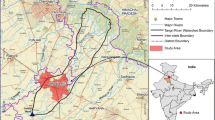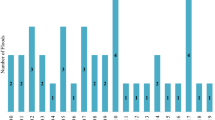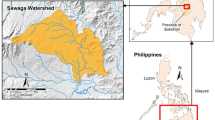Abstract
Makkah city, Saudi Arabia, is periodically exposed to flash floods that result in major human and economical damages. That is due to several factors including its rugged topography and geological structures. Hence, precise assessment of floods becomes a more vital demand in development planning. A GIS-based methodology has been developed for quantifying and spatially mapping the flood characteristics. The core of this new approach is integrating several topographic, metrological, geological, and land use data sets in a geographic information system (GIS) environment that utilizes the curve number method of flood modelling for ungauged arid catchments. Based on the estimated flood volume of sub-basins, a hazard factor has been developed to quantify the expected hazard level for each road. Applying this proposed approach reveals that 21 % of the road network in Makkah city is subjected to low flood hazards, 29 % is facing medium hazards, and 50 % of roads are exposed to harsh flood impacts. The developed approach may be considered a digital precise method that can be easily re-run, in other situations or regions, to estimate flood hazards on roads.









Similar content being viewed by others
References
Al Saud M (2010) Assessment of flood hazard of Jeddah area 2009, Saudi Arabia. J Water Resour Prot 2:839–847
Azab M (2009) Assessment and management of natural hazards and disasters along Qena–Safaga road, central eastern desert, Egypt. Egypt J Remote Sens Space Sci 12:55–70
Blanton P, Marcus A (2009) Railroads, roads and lateral disconnection in the river landscapes of the continental, United States. Geomorphology 112:12–227
Chang H, Franczyk J, Kim C (2009) What is responsible for increasing flood risks? Case Gangwon Prov Korea Nat Hazards 48:39–354
Chen J, Hill A, Urbano L (2010) A GIS-based model for urban flood inundation. J Hydrol 373:84–192
Dawod G, Koshak N (2011) Developing GIS-based unit hydrographs for flood management in Makkah metropolitan area, Saudi Arabia. J Geogr Inf Syst 3(2):153–159
Dongquan Z, Jining C, Haozheng W, Qingyuan T, Shangbing C, Zheng S (2009) GIS-based urban rainfall-runoff modeling using an automatic catchment-discretization approach: a case study in Macau. Environ Earth Sci 59:65–472
El Bastawesy M, White K, Nasr A (2009) Integration of remote sensing and GIS for modelling flash floods in Wadi Hudain catchment, Egypt. Hydrol Process 23:1359–1368
Fred E, Mostafa B (2008) Flood risk modeling for holy sites in Makkah. In: Proceedings of the symposium on national GIS application in Saudi Arabia, Al-Kober City, Saudi Arabia
Gogoase D, Armaş I, Ionescu C (2011) Inundation maps for extreme flood events at the mouth of the Danube River. Int J Geosci 2:8–74
Guptaa P, Panigrahya S (2008) Geo-spatial modeling of runoff of large land mass: analysis, approach and results for major river basins of India. In: Proceedings of the international archives of the photogrammetry, remote sensing and spatial information sciences, vol. XXXVII. Part B2. Beijing
Horton R (1945) Erosional development of streams and their drainage basins: hydrological approach to quantitative morphology. Geol Soc Bull 56:275–370
Huggett R (2007) Fundamentals of geomorphology, 2nd edn. Routledge, New York
IDoT (Iowa state Department of Transportation) (2009) Iowa storm water management manual
Jasrotia A, Singh R (2006) Modeling runoff and soil erosion in a catchment area, using the GIS, in the Himalayan region, India. Environ Geol 51:9–37
Karmakar S, Simonovic S, Peck A, Black J (2010) An information system for risk-vulnerability assessment to flood. J Geogr Inf Syst 2:29–146
Kim N, Lee JW, Lee J, Lee JE (2010) SWAT application to estimate design runoff curve number for South Korean conditions. Hydrol Process 24:156–2170
Liang W, Yongli C, Hongquan C, Daler D, Jingmin Z, Juan Y (2010) Flood disaster in Taihu Basin, China: causal chain and policy option analyses. Environ Earth Sci. doi:10.1007/s12665-010-0786-x
Mihalik E (2008) Watershed characterization and runoff modelling of the Chapel branch creek, Orangeburg county, South Carolina, MSC thesis, College of Charleston, South Carolina State, USA
Mirza M, Ahmed B (2001) Winter weather and climate conditions in Makkah (in Arabic), Geographic Messages, vol 253. Kuwait Geographic Association, Kuwait
NH DoT (New Hampshire Department of Transportation) (1998) Drainage design manual for highways
Raghunath H (2006) Hydrology: principles, analysis, and design. New Age International Ltd., New Delhi
Saleh A, Al-Hatrushi S (2009) Torrential flood hazards assessment, management, and mitigation, in Wadi Aday, Muscat area, Sultanate of Oman, a GIS and RS approach, Egypt. J Remote Sens Space Sci 12:1–86
Sen Z (2008) Wadi hydrology. CRC Press, New York
Şen Z, Al-Suba’l K (2002) Hydrological considerations for dam siting in arid regions: a Saudi Arabian study. Hydrol Sci J 2(47):173–186
US ACE (US Army Corps of Engineers) (2004) Physical stream assessment
US DoT (US Department of Transportation) (2002) Highway hydrology manual, Publication No. FHWA-02-001
US NRCS (US National Resources Conservation Services) (1986) Urban hydrology for small watersheds, Technical Manual TR55
USGS (2009) (U.S. Geological Survey) Watershed models for decision support for inflows to Potholes reservoir, Washington scientific investigations report 2009–5081
Yahaya S, Ahmad N, Abdalla R (2010) Multicriteria analysis for flood vulnerable areas in Hadejia–Jama’are river basin, Nigeria. Eur J Sci Res 42(1):1–83
Youssef A, Pradhan B, Hassan A (2010) Flash flood risk estimation along the St. Katherine road, southern Sinai, Egypt using GIS based morphometry and satellite imagery. Environ Earth Sci. doi:10.1007/s12665-010-0551-1
Yunus M, Hassan H (2010) Managing road maintenance using geographic information system application. J Geogr Inf Syst 2:15–219
Acknowledgments
The authors would like to acknowledge the financial support offered by the Center of Research Excellence in Hajj and Omrah (Hajjcore), Umm Al-Qura University, Saudi Arabia.
Author information
Authors and Affiliations
Corresponding author
Rights and permissions
About this article
Cite this article
Dawod, G.M., Mirza, M.N. & Al-Ghamdi, K.A. GIS-based estimation of flood hazard impacts on road network in Makkah city, Saudi Arabia. Environ Earth Sci 67, 2205–2215 (2012). https://doi.org/10.1007/s12665-012-1660-9
Received:
Accepted:
Published:
Issue Date:
DOI: https://doi.org/10.1007/s12665-012-1660-9




